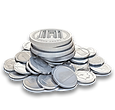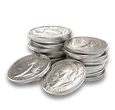The China Panda Gold Coin: A Collector’s Favorite and Investor’s Global Gold Asset
- GoldsilverJapan

- Jul 12
- 4 min read
The China Panda Gold Coin is one of the world’s most iconic modern bullion coins, known for its annually changing panda designs, high purity, and recognition among collectors and investors across Asia, Europe, and beyond.
Whether you're building a long-term gold portfolio or curating a numismatic collection, the Chinese Panda gold coin stands out for its combination of artistic beauty, government backing, and collectible appeal.
In this article, we explore:
✅ The history and origin of the Panda gold coin✅ Design changes over the decades✅ Weight and purity specifications✅ Why it’s a favorite for collectors✅ Benefits and challenges from an investment standpoint
A Brief History of the Panda Gold Coin
The People’s Republic of China introduced the Panda Gold Coin in 1982 through the China Mint Company. This was the first modern gold bullion coin to come out of China and has since become an internationally recognized product, competing with the likes of the American Gold Eagle and Canadian Maple Leaf.
From its inception, the Panda coin was designed not just as bullion—but as an artistic and cultural tribute to China's national symbol: the giant panda.
What makes the China Panda unique among global bullion coins is its annually changing design—something that appeals strongly to both investors and collectors.
Specifications: Weight, Purity, and Denomination
The Panda Gold Coin has undergone several updates to its specifications since its debut.
1982–2015:
Purity: .999 fine gold (99.9%)
Weights issued: 1 oz, 1/2 oz, 1/4 oz, 1/10 oz, 1/20 oz
Face values: Ranged from 500 yuan (1 oz) to 20 yuan (1/20 oz)
Minting location: China Gold Coin Incorporation, with various mints across China, including Beijing, Shanghai, and Shenyang.
From 2016 onwards:
China adopted the metric system for the Panda series, aligning it with local preferences.
New standard weights:
30 grams (replacing 1 oz)
15 grams
8 grams
3 grams
1 gram
Purity: Still .999 fine gold
Face values: Also adjusted accordingly (e.g., 500 yuan for 30g)
This shift caused some confusion in global markets at first, but the Panda's popularity quickly adjusted due to its uniqueness and the growing influence of China’s bullion market.
Design: Always Changing, Always Artistic
The Obverse:
Consistently features the Temple of Heaven in Beijing with the inscription “中华人民共和国” (People’s Republic of China) and the year of issue.
The Reverse:
A different panda design every year, often depicting pandas playing, climbing, or sitting with bamboo.
2001 and 2002 shared the same reverse design—resulting in collector demand to return to annual changes, which resumed in 2003.
This annual redesign is unique among major bullion coins, and is one of the reasons the China Panda Gold Coin is especially appealing to collectors. The emotional, cultural, and symbolic connection to the panda also deepens its global appeal.
Collectibility: Why Panda Gold Coins Are Coveted
Unlike many bullion coins that retain the same design year after year, the Panda series is essentially half bullion, half art.
🔹 Collectors love the year-by-year design variations, and older dates (especially pre-2000) can carry significant premiums over spot price.🔹 Low mintage years (such as 1982–1985) are especially rare.🔹 In Chinese culture, pandas symbolize peace, prosperity, and friendship—adding emotional and cultural value to the coin.
Also, China’s growing domestic middle-class and investor base has created internal demand, sometimes making supply scarce internationally.
Investment Value: Pros and Challenges
✅ Benefits:
Recognized worldwide, especially in Asia and emerging markets
Government guaranteed for weight and purity
Strong liquidity, especially in China and among international dealers
Collector upside from design appeal and limited mintage
Excellent long-term performance in both bullion and numismatic value
⚠️ Challenges:
Premiums over spot can be higher than American Eagles or Maple Leafs, especially for older issues
Metric weight system (30g vs. 1 oz) may require explanation or conversion for international investors
Counterfeit risk: Like all high-demand coins, Pandas are sometimes forged, so buying from reputable dealers is essential
Tips for Buying China Panda Gold Coins
Stick to certified coins (NGC/PCGS) if you plan to collect high-grade examples.
Store in protective capsules to avoid scratches, as designs are detailed and delicate.
Understand the weight system if stacking for bullion; 30g is ~96.7% of a troy ounce.
Older issues (1980s–1990s) often carry collectible premiums—research before buying.
Buy from established dealers like GoldSilverJapan to ensure authenticity and fair pricing.
Final Thoughts: The Panda Is More Than a Coin—It’s Cultural Gold
The China Panda Gold Coin is a unique blend of artistry, collectibility, and investment-grade bullion. It reflects the rise of China’s global economic power and cultural identity, and offers global investors a gold product that stands apart from more generic bullion coins.
Whether you are stacking for long-term wealth protection, or building a beautiful year-by-year collection, the Panda coin offers a trusted, internationally traded option with a distinct aesthetic and historical flavor.
Buy China Panda Gold Coins at GoldSilverJapan
At GoldSilverJapan, we provide:
✅ Multiple years of Panda Gold Coins (from 1980s to recent issues)✅ Transparent pricing linked to live gold spot prices✅ Buyback guarantee and clear resale policies✅ Japanese and English customer support✅ Access to graded and ungraded options
Add the Panda Gold Coin to Your Precious Metals Portfolio Today
GoldSilverJapan: Your Trusted Partner for International Bullion with Local Expertise.











Comments